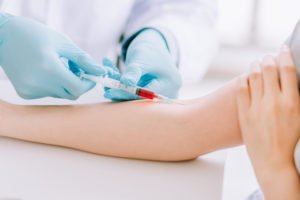
While a blood test is usually more accurate than a breathalyzer at determining someone’s blood alcohol content or blood alcohol concentration (BAC), blood tests are more difficult to administer. They are also far more intrusive than a breath test. This is why most cases of driving under the influence (DUI) involve evidence from breathalyzers rather than from blood tests.
Are blood tests more accurate than breath tests?
Blood tests generally produce more accurate results than breathalyzers and other breath tests. Blood tests directly measure the suspect’s actual BAC. Breath tests only indirectly measure someone’s BAC. Blood tests are also less susceptible to environmental factors that can skew the results.
Unlike breath tests, blood tests take a sample of a DUI suspect’s blood and measure the amount of alcohol in the sample. Because it does not rely on the alcohol in the blood transferring to the air that is then exhaled from the lungs, the results from blood tests are often more accurate.
Blood tests are also less prone to environmental factors creating an inaccuracy in the results. Breath tests can produce false positives if there is latent alcohol in the suspect’s mouth. This can happen if the driver:
- recently used mouthwash or a breath freshener,
- has not eaten in a while,
- burps soon before the breath test is administered, bringing extra alcohol up from the stomach into the mouth,
- ate food that was cooked in an alcoholic drink, like cooking wine,
- wears dentures that use an adhesive,
- is on certain medications, especially those that are administered with an inhaler, or
- took an over-the-counter medicine, like a cough syrup.
There are also other environmental factors that come from the surroundings that can impact a breath test’s results, like:
- fumes from recently painted or cleaned surfaces,
- dust particles in the air from a recently deployed airbag, and
- any alcohol remaining in the breathalyzer’s mouthpiece from a prior BAC test.
Blood tests are not susceptible to these environmental factors because they draw the blood sample directly from the driver’s vein.
A DUI defense attorney knows to look for signs that these environmental factors led to a false positive on the breath test.
How do breathalyzers determine a driver’s BAC?
Breathalyzer tests measure a driver’s breath alcohol content, or BrAC. The BrAC numbers are then converted into BAC numbers.
When people consume alcohol, the alcohol travels through the esophagus, into the stomach and to the small intestine. There, the alcohol diffuses into the bloodstream. In the bloodstream, the alcohol circulates throughout the body. This takes it through the lungs. There, some of the alcohol in the blood diffuses into the lungs. Once in the lungs, it is released whenever the person exhales.
The alcohol in the person’s exhalation is detectable in the breath sample collected by a breathalyzer. Alcohol can be detected by a breathalyzer for about 24 hours.
The BrAC in a breath sample is calculated as grams of alcohol per 210 liters of breath. This is then converted into BAC, which is calculated as milligrams of alcohol per 100 milliliters of blood.
Because there is more science involved, there is more that can go wrong and skew the results. A DWI or DUI lawyer from a local law firm can help defendants challenge the BAC testing results, protect the defendant’s driver’s license, and fight the DUI charges.
Why do police use breath tests more often in DUI cases?
Even though blood alcohol tests tend to be more accurate, police still use chemical tests or breathalyzers during DUI investigations because blood tests are difficult to administer. Breath tests, on the other hand, do not require extensive training or a medical license. They can also be administered on the roadside, in an uncontrolled setting. They also produce immediate results that show the driver’s BAC levels and whether the driver is at or above the legal limit.
The convenience and portability of breath testing devices continue to make them the most common type of evidence-gathering device in DUI cases. This is why police tend to use a portable, handheld breathalyzer at the traffic stop to get probable cause to initiate a DUI arrest, and then a more accurate breathalyzer at the police station to gather admissible evidence of drunk driving. This is much more common than police arresting someone on suspicion of drunk driving and then bringing the driver to the hospital to administer a blood test.
Police officers also use breathalyzers more often because they produce breath test results very quickly. A BAC reading can happen in a matter of seconds. Blood tests require lab work. This can delay the blood test results for multiple hours. In the meantime, police have to hold the suspect in custody.
Are there situations where a blood test is more common?
Law enforcement officers are more likely to use a blood test if the incident involved a car accident and the drunk driving suspect is hurt and in the hospital, already. In these cases, medical professionals are often already administering a blood draw. Police then request that it be tested for its blood alcohol level.

